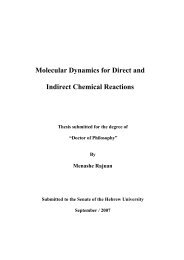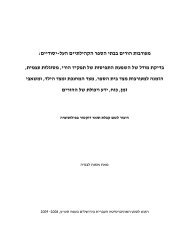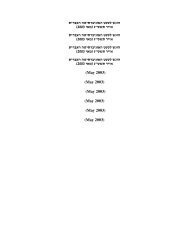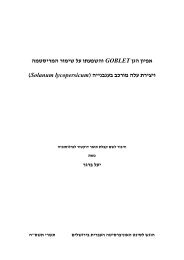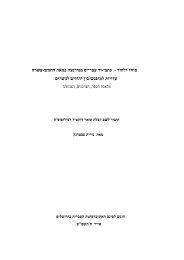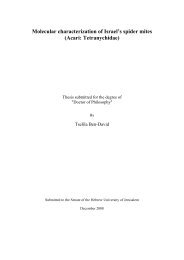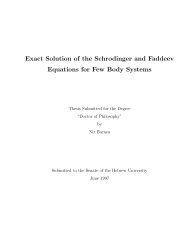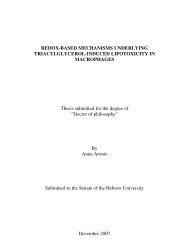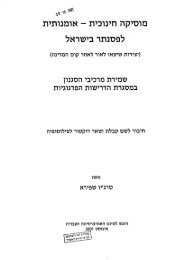Revealing the Mechanism of HSP104 Transcription Initiation in the ...
Revealing the Mechanism of HSP104 Transcription Initiation in the ...
Revealing the Mechanism of HSP104 Transcription Initiation in the ...
You also want an ePaper? Increase the reach of your titles
YUMPU automatically turns print PDFs into web optimized ePapers that Google loves.
In mammalian cells, Hsf1 is a monomeric cytoplasmic prote<strong>in</strong>, that <strong>in</strong><br />
response to stress is recruited to <strong>the</strong> nucleus, trimerized and b<strong>in</strong>ds DNA (45, 90, 118,<br />
133, 134). By contrast, <strong>in</strong> yeast, Hsf1 was shown to be constitutively homotrimerized<br />
and to constitutively b<strong>in</strong>d HSEs (61, 117). However, a more detailed study, that<br />
analyzed Hsf1 b<strong>in</strong>d<strong>in</strong>g <strong>in</strong> vivo us<strong>in</strong>g ChIP asays, suggested that some promoters b<strong>in</strong>d<br />
Hsf1 only follow<strong>in</strong>g stress, similar to <strong>the</strong> case <strong>in</strong> mammalian cells (51, 135). It was<br />
found that <strong>in</strong> Drosophila, upon activation, Hsf1 b<strong>in</strong>ds HSEs and recruits mediator<br />
complexes to heat shock loci as part <strong>of</strong> a cascade <strong>of</strong> events lead<strong>in</strong>g to transcription<br />
activation. In fact, this recruitment seems to <strong>in</strong>volve direct <strong>in</strong>teraction between Hsf1<br />
and components <strong>of</strong> <strong>the</strong> mediator complex (95). In addition, Hsf1 <strong>of</strong> mammalian cells<br />
has been shown to <strong>in</strong>teract <strong>in</strong> vitro and <strong>in</strong> vivo with <strong>the</strong> chromat<strong>in</strong> remodel<strong>in</strong>g<br />
complex SWI/SNF (123). Chromat<strong>in</strong> remodel<strong>in</strong>g activities on purified nucleosome<br />
templates were also shown to be dependent upon <strong>the</strong>ir recruitment via Hsf1 (123).<br />
These reports <strong>in</strong>deed lead to <strong>the</strong> f<strong>in</strong>d<strong>in</strong>g that <strong>in</strong> yeast, <strong>in</strong>teractions between Hsf1 and<br />
components <strong>of</strong> <strong>the</strong> mediator do exist and that mediator complex can be recruited to<br />
promoters via Hsf1 (39).<br />
The STRE/Msn2/Msn4 system<br />
As is shown <strong>in</strong> Figure 1, <strong>the</strong> promoter <strong>of</strong> <strong>HSP104</strong> conta<strong>in</strong>s several repeats <strong>of</strong><br />
<strong>the</strong> sequence 5’ AGGGG 3’ or 5’ CCCCT 3’. These sequences are known as STress<br />
Response Elements (STREs). STREs were orig<strong>in</strong>ally identified <strong>in</strong> <strong>the</strong> promoters <strong>of</strong><br />
CTT1 and DDR2 genes [encod<strong>in</strong>g <strong>the</strong> cytoplasmic catalase and DNA damage<br />
response prote<strong>in</strong>s respectively (68, 132)] whose transcription are highly <strong>in</strong>duced<br />
under oxidative stress and exposure to DNA damag<strong>in</strong>g agents respectively.<br />
Unexpectedly, it was found that CTT1 transcription was also elevated <strong>in</strong> response to<br />
heat shock, although it does not conta<strong>in</strong> any HSE (132). Fur<strong>the</strong>rmore, it has been<br />
shown that DDR2 can be transcriptionally activated not only by DNA damag<strong>in</strong>g<br />
agents, but also by thirteen o<strong>the</strong>r stresses <strong>in</strong>clud<strong>in</strong>g osmotic shock, nitrogen starvation<br />
oxidative stress and stationary phase (126). Promoter analysis <strong>of</strong> CTT1 and DDR2<br />
revealed that transcription activation <strong>in</strong> response to all <strong>the</strong>se stresses is dependent on<br />
short sequences that were termed STREs (68, 86). STREs were <strong>the</strong>n identified <strong>in</strong> <strong>the</strong><br />
promoters <strong>of</strong> hundreds <strong>of</strong> stress related genes (17, 91). The promoter <strong>of</strong> <strong>HSP104</strong><br />
conta<strong>in</strong>s three classical STREs positioned at -172, -220 and -252bp from <strong>the</strong> ATG<br />
[Fig. 1 and ref. (47)].<br />
8



